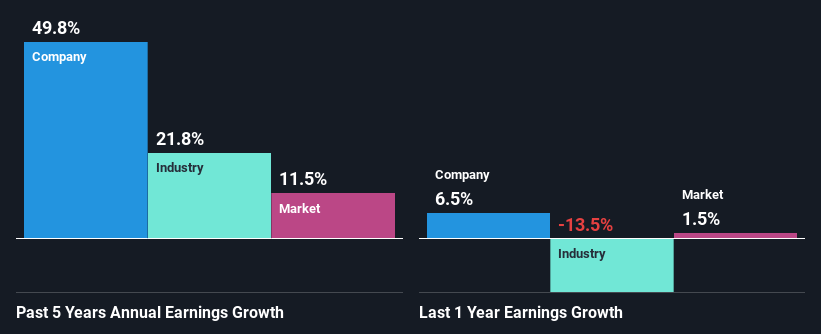Stock Analysis
- United Kingdom
- /
- Oil and Gas
- /
- AIM:UJO
Union Jack Oil plc's (LON:UJO) Stock's On An Uptrend: Are Strong Financials Guiding The Market?

Union Jack Oil (LON:UJO) has had a great run on the share market with its stock up by a significant 16% over the last week. Given that the market rewards strong financials in the long-term, we wonder if that is the case in this instance. In this article, we decided to focus on Union Jack Oil's ROE.
ROE or return on equity is a useful tool to assess how effectively a company can generate returns on the investment it received from its shareholders. In short, ROE shows the profit each dollar generates with respect to its shareholder investments.
See our latest analysis for Union Jack Oil
How To Calculate Return On Equity?
ROE can be calculated by using the formula:
Return on Equity = Net Profit (from continuing operations) ÷ Shareholders' Equity
So, based on the above formula, the ROE for Union Jack Oil is:
9.6% = UK£2.1m ÷ UK£22m (Based on the trailing twelve months to June 2023).
The 'return' refers to a company's earnings over the last year. One way to conceptualize this is that for each £1 of shareholders' capital it has, the company made £0.10 in profit.
What Is The Relationship Between ROE And Earnings Growth?
So far, we've learned that ROE is a measure of a company's profitability. Depending on how much of these profits the company reinvests or "retains", and how effectively it does so, we are then able to assess a company’s earnings growth potential. Assuming all else is equal, companies that have both a higher return on equity and higher profit retention are usually the ones that have a higher growth rate when compared to companies that don't have the same features.
Union Jack Oil's Earnings Growth And 9.6% ROE
To begin with, Union Jack Oil seems to have a respectable ROE. Yet, the fact that the company's ROE is lower than the industry average of 16% does temper our expectations. That being the case, the significant five-year 50% net income growth reported by Union Jack Oil comes as a pleasant surprise. Therefore, there could be other causes behind this growth. For instance, the company has a low payout ratio or is being managed efficiently. Bear in mind, the company does have a respectable ROE. It is just that the industry ROE is higher. So this certainly also provides some context to the high earnings growth seen by the company.
As a next step, we compared Union Jack Oil's net income growth with the industry, and pleasingly, we found that the growth seen by the company is higher than the average industry growth of 22%.

The basis for attaching value to a company is, to a great extent, tied to its earnings growth. It’s important for an investor to know whether the market has priced in the company's expected earnings growth (or decline). By doing so, they will have an idea if the stock is headed into clear blue waters or if swampy waters await. One good indicator of expected earnings growth is the P/E ratio which determines the price the market is willing to pay for a stock based on its earnings prospects. So, you may want to check if Union Jack Oil is trading on a high P/E or a low P/E, relative to its industry.
Is Union Jack Oil Making Efficient Use Of Its Profits?
Union Jack Oil has a really low three-year median payout ratio of 11%, meaning that it has the remaining 89% left over to reinvest into its business. This suggests that the management is reinvesting most of the profits to grow the business as evidenced by the growth seen by the company.
Along with seeing a growth in earnings, Union Jack Oil only recently started paying dividends. Its quite possible that the company was looking to impress its shareholders.
Summary
On the whole, we feel that Union Jack Oil's performance has been quite good. Specifically, we like that it has been reinvesting a high portion of its profits at a moderate rate of return, resulting in earnings expansion. If the company continues to grow its earnings the way it has, that could have a positive impact on its share price given how earnings per share influence long-term share prices. Not to forget, share price outcomes are also dependent on the potential risks a company may face. So it is important for investors to be aware of the risks involved in the business. You can see the 3 risks we have identified for Union Jack Oil by visiting our risks dashboard for free on our platform here.
Valuation is complex, but we're helping make it simple.
Find out whether Union Jack Oil is potentially over or undervalued by checking out our comprehensive analysis, which includes fair value estimates, risks and warnings, dividends, insider transactions and financial health.
View the Free AnalysisHave feedback on this article? Concerned about the content? Get in touch with us directly. Alternatively, email editorial-team (at) simplywallst.com.
This article by Simply Wall St is general in nature. We provide commentary based on historical data and analyst forecasts only using an unbiased methodology and our articles are not intended to be financial advice. It does not constitute a recommendation to buy or sell any stock, and does not take account of your objectives, or your financial situation. We aim to bring you long-term focused analysis driven by fundamental data. Note that our analysis may not factor in the latest price-sensitive company announcements or qualitative material. Simply Wall St has no position in any stocks mentioned.
About AIM:UJO
Union Jack Oil
Operates as an onshore oil and gas company in the United Kingdom and the United States.
Flawless balance sheet low.

